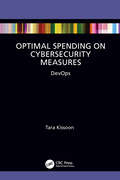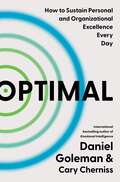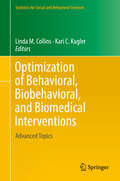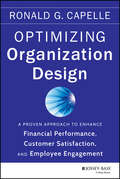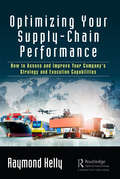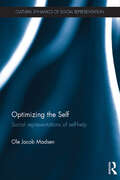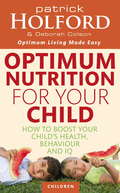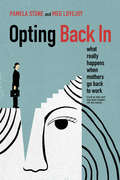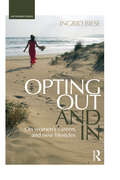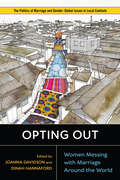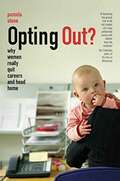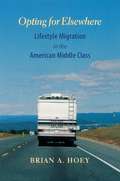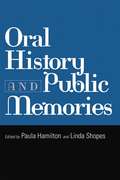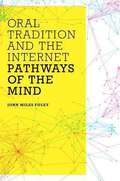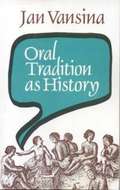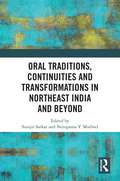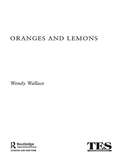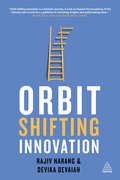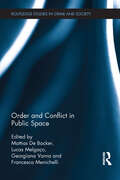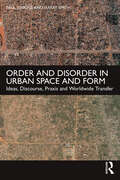- Table View
- List View
Optimal Spending on Cybersecurity Measures: DevOps
by Tara KissoonOptimal Spending on Cybersecurity Measures: DevOps aims to discuss the integration of risk management methodologies within the DevOps process.This book introduces the cyber risk investment model, and the cybersecurity risk management framework within the DevOps process. This can be used by various stakeholders who are involved in the implementation of cybersecurity measures to safeguard sensitive data. This framework facilitates an organization’s risk management decision-making process to demonstrate the mechanisms in place to fund cybersecurity measures within DevOps practices, and demonstrates the application of the process using a case study: Cascade. This book also discusses the elements used within DevOps, DevSecOps, and will define a strategic approach to minimize cybersecurity risks within DevOps known as DevRiskOps.Features: Aims to strengthen the reader’s understanding of industry governance, risk and compliance practices. Incorporates an innovative approach to assess cyber security initiatives with DevOps. Explores the strategic decisions made by organizations when implementing cybersecurity measures and leverages an integrated approach to include risk management elements into DevOps.
Optimal: How to Sustain Personal and Organizational Excellence Every Day
by Daniel Goleman Cary ChernissIn his groundbreaking #1 bestseller Emotional Intelligence, Daniel Goleman revolutionized how we think about intelligence. Now, he reveals practical methods for using these inner resources to more readily enter an optimal state of high performance and satisfaction while avoiding burnout. There are moments when we achieve peak performance: An athlete plays a perfect game; a business has a quarter with once-in-a-lifetime profits. But these moments are often elusive, and for every amazing day, we may have a hundred ordinary and even unsatisfying days. Fulfillment doesn’t come from isolated peak experiences, but rather from many consistent good days. So how do we sustain performance, while avoiding burnout and maintaining balance? In Optimal, Daniel Goleman and Cary Cherniss reveal how emotional intelligence can help us have a great day, any day. They explain how to set a realistic, attainable goal of feeling satisfied that you’ve had a productive day — to consistently work at your ‘optimal’ level. Based on research of how hundreds of people build the inner architecture of having a good day, they sketch what an optimal state feels like, and show how emotional intelligence holds the key to our best performance.Optimal is the culmination of decades of scientific discoveries bearing on emotional intelligence. Enhanced emotional intelligence pays off in improved engagement, productivity, and more satisfying days. In this book, you’ll find the keys to competence in emotional intelligence, and practical methods for applying this skill set more readily. It will equip you to become a highly effective leader and enable you to build an organizational culture that empowers workers to sustain high performance.
Optimising Female Athletic Performance
by Simon Rea Jess Pinchbeck Candice Lingam-WillgossOptimising Female Athletic Performance presents a comprehensive overview of the wide range of factors that underpin female athletic performance based on the most up to date research. This book draws from the disciplines of anatomy, physiology, psychology, and sociology to develop an integrated approach and illustrates how female athletes can be safely prepared for training and performance in a way that benefits their health and optimises their performance. The book covers the specific challenges active females encounter as they move through their lives from childhood, puberty, adolescence, adulthood, potentially motherhood, and on to the menopausal stage.As well as presenting the key knowledge and research around female athletic performance, each chapter includes real world examples in the form of case studies and athletes’ experiences. Each chapter concludes with a summary offering key points and take away messages for coaches and practicing athletes, as well as end of chapter quizzes to allow students to assess their own learning and knowledge.Optimising Female Athletic Performance is key reading for undergraduate students studying sports science and sports coaching degrees who aspire to a career working with female athletes in a range of contexts and environments. Content has been presented in a way that is easily accessible to students and to facilitate the practical application of knowledge by practitioners in a range of sport and exercise settings. It is also useful to active females to understand their own performance and enhance their experience of sport and fitness.
Optimization of Behavioral, Biobehavioral, and Biomedical Interventions: Advanced Topics (Statistics for Social and Behavioral Sciences)
by Linda M. Collins Kari C. KuglerBehavioral, biobehavioral, and biomedical interventions are programs with the objective of improving and maintaining human health and well-being, broadly defined, in individuals, families, schools, organizations, or communities. These interventions may be aimed at, for example, preventing or treating disease, promoting physical and mental health, preventing violence, or improving academic achievement. This book provides additional information on a principled empirical framework for developing interventions that are more effective, efficient, economical, and scalable. This framework is introduced in the monograph, "Optimization of Behavioral, Biobehavioral, and Biomedical Interventions: The Multiphase Optimization Strategy (MOST)" by Linda M. Collins (Springer, 2018). The present book is focused on advanced topics related to MOST. The chapters, all written by experts, are devoted to topics ranging from experimental design and data analysis to development of a conceptual model and implementation of a complex experiment in the field. Intervention scientists who are preparing to apply MOST will find this book an important reference and guide for their research. Fields to which this work pertains include public health (medicine, nursing, health economics, implementation sciences), behavioral sciences (psychology, criminal justice), statistics, and education.
Optimizing Data-to-Learning-to-Action: The Modern Approach To Continuous Performance Improvement For Businesses
by Steven FlinnApply a powerful new approach and method that ensures continuous performance improvement for your business. You will learn how to determine and value the people, process, and technology-based solutions that will optimize your organization’s data-to-learning-to-action processes. This book describes in detail how to holistically optimize the chain of activities that span from data to learning to decisions to actions, an imperative for achieving outstanding performance in today’s business environment. Adapting and integrating insights from decision science, constraint theory, and process improvement, the book provides a method that is clear, effective, and can be applied to nearly every business function and sector. You will learn how to systematically work backwards from decisions to data, estimate the flow of value along the chain, and identify the inevitable value bottlenecks. And, importantly, you will learn techniques for quantifying the value that can be attained by successfully addressing the bottlenecks, providing the credible support needed to make the right level of investments at the right place and at just the right time. In today’s dynamic environment, with its never-ending stream of new, disruptive technologies that executives must consider (e.g., cloud computing, Internet of Things, AI/machine learning, business intelligence, enterprise social, etc., along with the associated big data generated), author Steven Flinn provides the comprehensive approach that is needed for making effective decisions about these technologies, underpinned by credibly quantified value. What You’ll LearnUnderstand data-to-learning-to-action processes and their fundamental elementsDiscover the highest leverage data-to-learning-to-action processes in your organizationIdentify the key decisions that are associated with a data-to-learning-to-action processKnow why it’s NOT all about data, but it IS all about decisions and learningDetermine the value upside of enhanced learning that can improve decisionsWork backwards from the decisions to determine the value constraints in data-to-learning-to-action processesEvaluate people, process, and technology-based solution options to address the constraintsQuantify the expected value of each of the solution options and prioritize accordinglyImplement, measure, and continuously improve by addressing the next constraints on valueWho This Book Is For Business executives and managers seeking the next level of organizational performance, knowledge workers who want to maximize their impact, technology managers and practitioners who require a more effective means to prioritize technology options and deployments, technology providers who need a way to credibly quantify the value of their offerings, and consultants who are ready to build practices around the next big business performance paradigm
Optimizing Organization Design
by Ronald G. CapelleOptimizing Organization Design offers a comprehensive resource and valued guide for anyone interested in improving organization performance. The book presents an approach to optimizing organization design that is based on over 100 large scale projects and 23 research studies that have been completed by Capelle Associates over the past 25 years. In addition, the book includes insightful comments from executives on their success in using this approach. Capelle's research and client experience reveal that optimizing organization design leads to better financial performance, customer satisfaction and employee engagement. It can provide a competitive advantage and a significant return on investment. It can also become the foundation of both strategy implementation and human resources management.Capelle shows that organization design includes the alignment of a number of critical factors, including positions (vertical and functional); accountabilities and authorities (managerial and cross functional); people; deliverables and tasks. He shows that manager - direct report alignment is the single most important organization design variable. His research also shows that it is suboptimal nearly half the time. This is a horrendous waste of talent and capability, but also provides a significant opportunity for improvement in organization performance. Optimizing Organization Design clearly explains how to implement organization design improvements. This approach includes people change management, project management, and a cascading, iterative approach that is based on teams and involves education, doing real work and feedback. In addition, Optimizing Organization Design includes special sections on the role of the Board of Directors, project management, process management and compensation. In addition, the author has included four case studies and a useful glossary.
Optimizing Your Supply-Chain Performance: How to Assess and Improve Your Company's Strategy and Execution Capabilities
by Raymond KellyMost companies are continuously trying to reduce their supply-chain costs, time to market, and inventory. Optimizing Your Supply-Chain Performance: How to Assess and Improve Your Company’s Strategy and Execution Capabilities presents the "how-to's" (and a few "how-NOT-to’s"!) for conducting assessments of companies’ supply chains as well as identifying areas for improvement. It covers techniques, tools, and methodologies for evaluating current working methods (current state) versus industry best practices and operational optimization. It identifies performance gaps and suggests planning and implementing improved ways of working (the future and ideal states). With a collection of approximately 40 case-in-point examples of supply-chain transformation across a wide array of industries including Fortune 1000 companies as well as foreign global leaders, this book provides a detailed guide for assessing and improving organizational strategy and execution-capabilities for: Inventory management Order fulfillment Sourcing and purchasing Manufacturing planning, scheduling, and execution Overall supply-chain effectiveness Business continuity planning Essentially, this book provides basic knowledge for assessing, improving, and optimizing the end-to-end supply chain, and the case-in-point examples assist in breaking down theories into simple, actionable improvement activities. The author stresses the importance of business continuity and provides grassroots approaches to identifying risks. Based on the author's vast experience out in the field, it gives professionals a new perspective and inspires them to seek world-class performance.
Optimizing the Self: Social representations of self-help (Cultural Dynamics of Social Representation)
by Ole Jacob MadsenThis book provides an analysis of the social representations of leading self-help genres, including neurolinguistic programming, cognitive self-help therapy, mindfulness, self-management, self-esteem, self-leadership and self-control. Exploring the globalised therapeutic culture of today, the book argues that psychology as ‘science’ is often abandoned to aid the individual pursuit for self-realization and self-optimization. Opposing the view that self-help culture is external to psychology, Madsen argues that it is firmly embedded within psychology, playing an important role in people’s lives. Each chapter traces and critically interprets a range of self-help philosophies and techniques, examining the claims of self-help literature to represent the most innovative psychological, medical or neurobiological research. Discussing each genre in turn, chapters examine key research alongside self-help literature to explore the effectiveness and impact of leading self-help genres in various social contexts and environments. The book offers a contemporary critical overview of issues concerning self-help, combining critical psychology with the theory of social representation to provide a broad perspective on self-help as a valid psychology. Optimizing the Self will be of interest to academics, researchers and postgraduate students in the fields of social representation, critical and cultural psychology and theory, clinical psychology, and the sociology of culture and science. The book will also be of use to critical and cultural psychologists and theorists, as well as clinical psychologists.
Optimum Nutrition For Your Child: How to boost your child's health, behaviour and IQ
by Patrick Holford BSc, DipION, FBA Optimum Nutritio Deborah ColsonPatrick Holford illustrated the connection between nutrition and all aspects of health in his best-selling book THE OPTIMUM NUTRITION BIBLE. In OPTIMUM NUTRITION FOR YOUR CHILD, he reveals how crucial optimum nutrition is for children's general health and development, as well as their behaviour and IQ. He explains why certain foods are so beneficial and why others are damaging, and enables you to identify common problems in children which can be improved or solved with the right foods and supplements. With invaluable advice on getting children to eat healthy food, food plans and practical tips, this book is the definitive guide for parents.
Opting Back In: What Really Happens When Mothers Go Back to Work
by Pamela Stone Meg LovejoyTaking a career break is a conflicted and risky decision for high-achieving professional women. Yet many do so, usually planning, even as they quit, to return to work eventually. But can they? And if so, how? In Opting Back In, Pamela Stone and Meg Lovejoy revisit women first interviewed a decade earlier in Stone’s book Opting Out? Why Women Really Quit Careers and Head Home to answer these questions. In frank and intimate accounts, women lay bare the dilemmas they face upon reentry. Most succeed but not by returning to their former high-paying, still family-inhospitable jobs. Instead, women strike out in new directions, finding personally gratifying but lower-paid jobs in the gig economy or predominantly female nonprofit sector. Opting Back In uncovers a paradox of privilege by which the very women best positioned to achieve leadership and close gender gaps use strategies to resume their careers that inadvertently reinforce gender inequality. The authors advocate gender equitable policies that will allow women—and all parents—to combine the intense demands of work and family life in the twenty-first century.
Opting Out and In: On Women’s Careers and New Lifestyles (Antinomies)
by Ingrid BieseOpting Out and In: On women’s careers and new lifestyles introduces a new perspective and definition of opting out that better reflects contemporary issues and lifestyles. The book offers a timely and comprehensive analysis of the phenomenon of women leaving high-powered careers, adding to current debates on opting out. It investigates the themes of globalization, individualization and the age of high modernity and addresses issues of how gender, in the context of what it means to be a mother and career woman in a masculinist society, affects decisions to opt out. In contrast to previous debates, the definition of opting out is broadened to include leaving prevalent masculinist notions of career to adopt alternative ways of working. To better understand the identity issues and inner workings of the women who opt out, opting out is critically examined through three lenses: agency and autonomy; gender, femininity and the maternal; and, finally, concepts of reinvention. These three areas of inquiry all raise and problematize relevant issues that are present in women’s lives, and that have a deep and defining effect on concepts of the self. The book includes the narratives of six women, interwoven with in-depth social theory and relevant debates. Written in an engaging and accessible style, Opting Out and In will strongly appeal to researchers and practitioners alike, working in areas such as social theory, globalization, feminist studies and identity studies.
Opting Out of the European Union
by Rebecca Adler-NissenEuropean integration continues to deepen despite major crises and attempts to take back sovereignty. A growing number of member states are reacting to a more constraining EU by negotiating opt-outs. This book provides the first in-depth account of how opt-outs work in practice. It examines the most controversial cases of differentiated integration: the British and Danish opt-outs from Economic and Monetary Union and European policies on borders, asylum, migration, internal security and justice. Drawing on over one hundred interviews with national representatives and EU officials, the author demonstrates how representatives manage the stigma of opting out, allowing them to influence even politically sensitive areas covered by their opt-outs. Developing a political sociology of European integration, the book shows how everyday negotiations transform national interests into European ideals. It is usually assumed that states opt out to preserve sovereignty, but Adler-Nissen argues that national opt-outs may actually reinforce the integration process.
Opting Out: Women Messing with Marriage around the World (Politics of Marriage and Gender: Global Issues in Local Contexts)
by Laura C. Nelson Sarah Lamb Carla Freeman Akiko Takeyama Jacqueline Solway Dinah Hannaford Julia Pauli Melanie A. Medeiros Joanna Davidson Kimberly Walters Brady G'Sell Carla JonesWomen around the world are opting out of marriage. Through nuanced ethnographic accounts of the ways that women are moving the needle on marital norms and practices, Opting Out reveals the conditions that make this widespread phenomenon possible in places where marriage has long been obligatory. Each chapter invites readers into the lives of particular women and the changing circumstances in which these lives unfold - sometimes painfully, sometimes humorously, and always unexpectedly. Taken together, the essays in this volume prompt the following questions: Why is marriage so consistently disappointing for women? When the rewards of economic stability and the social status that marriage confers are troubled, does marriage offer women anything compelling at all? Across diverse geographic contexts in Africa, Asia, and Latin America, this book offers sensitive and powerful portrayals of women as they escape or reshape marriage into a more rewarding arrangement.
Opting Out?: Why Women Really Quit Careers And Head Home
by Pamela StoneNoting a phenomenon that might seem to recall a previous era, The New York Times Magazine recently portrayed women who leave their careers in order to become full-time mothers as “opting out.” But, are high-achieving professional women really choosing to abandon their careers in order to return home? This provocative study is the first to tackle this issue from the perspective of the women themselves. Based on a series of candid, in-depth interviews with women who returned home after working as doctors, lawyers, bankers, scientists, and other professions, Pamela Stone explores the role that their husbands, children, and coworkers play in their decision; how women’s efforts to construct new lives and new identities unfold once they are home; and where their aspirations and plans for the future lie. What we learn―contrary to many media perceptions―is that these high-flying women are not opting out but are instead being pushed out of the workplace. Drawing on their experiences, Stone outlines concrete ideas for redesigning workplaces to make it easier for women―and men―to attain their goal of living rewarding lives that combine both families and careers.
Opting for Elsewhere: Lifestyle Migration in the American Middle Class
by Brian A. Hoey"Do you get told what the good life is, or do you figure it out for yourself?" This is the central question of Opting for Elsewhere, as the reader encounters stories of people who chose relocation as a way of redefining themselves and reordering work, family, and personal priorities. This is a book about the impulse to start over. Whether downshifting from stressful careers or being downsized from jobs lost in a surge of economic restructuring, lifestyle migrants seek refuge in places that seem to resonate with an idealized, potential self. Choosing the "option of elsewhere" and moving as a means of remaking self through sheer force of will are basic facets of American character, forged in its history as a developing nation of immigrants with a seemingly ever-expanding frontier. Building off years of interviews and research in the Midwest, including areas of Michigan, Brian Hoey provides an evocative illustration of the ways these sweeping changes impact people and the communities where they live and work as well as how both react--devising strategies for either coping with or challenging the status quo. This portrait of starting over in the heartland of America compels the reader to ask where we are going next as an emerging postindustrial society.
Opting for Elsewhere: Lifestyle Migration in the American Middle Class
by Brian Hoey"Do you get told what the good life is, or do you figure it out for yourself?" This is the central question of Opting for Elsewhere, as the reader encounters stories of people who chose relocation as a way of redefining themselves and reordering work, family, and personal priorities. This is a book about the impulse to start over. Whether downshifting from stressful careers or being downsized from jobs lost in a surge of economic restructuring, lifestyle migrants seek refuge in places that seem to resonate with an idealized, potential self. Choosing the "option of elsewhere" and moving as a means of remaking self through sheer force of will are basic facets of American character, forged in its history as a developing nation of immigrants with a seemingly ever-expanding frontier. Building off years of interviews and research in the Midwest, including areas of Michigan, Brian Hoey provides an evocative illustration of the ways these sweeping changes impact people and the communities where they live and work as well as how both react--devising strategies for either coping with or challenging the status quo. This portrait of starting over in the heartland of America compels the reader to ask where we are going next as an emerging postindustrial society.
Oral History and Education
by Kristina R. Llewellyn Nicholas Ng-A-FookThis book considers if and how oral history is 'best practice' for education. International scholars, practitioners, and teachers consider conceptual approaches, methodological limitations, and pedagogical possibilities of oral history education. These experts ask if and how oral history enables students to democratize history; provides students with a lens for understanding nation-states' development; and supports historical thinking skills in the classrooms. This book provides the first comprehensive assessment of oral history education - inclusive of oral tradition, digital storytelling, family histories, and testimony - within the context of 21st century schooling. By addressing the significance of oral history for education, this book seeks to expand education's capacity for teaching and learning about the past.
Oral History and Public Memories
by Hamilton Linda Paula ShopesOral history is inherently about memory, and when oral history interviews are used "in public," they invariably both reflect and shape public memories of the past. Oral History and Public Memories is the only book that explores this relationship, in fourteen case studies of oral history's use in a variety of venues and media around the world. Readers will learn, for example, of oral history based efforts to reclaim community memory in post-apartheid Cape Town, South Africa; of the role of personal testimony in changing public understanding of Japanese American history in the American West; of oral history's value in mapping heritage sites important to Australia's Aboriginal population; and of the way an oral history project with homeless people in Cleveland, Ohio became a tool for popular education. Taken together, these original essays link the well established practice of oral history to the burgeoning field of memory studies.
Oral Tradition and the Internet: Pathways of the Mind
by John Miles FoleyThe major purpose of this book is to illustrate and explain the fundamental similarities and correspondences between humankind's oldest and newest thought-technologies: oral tradition and the Internet. Despite superficial differences, both technologies are radically alike in depending not on static products but rather on continuous processes, not on "What?" but on "How do I get there?" In contrast to the fixed spatial organization of the page and book, the technologies of oral tradition and the Internet mime the way we think by processing along pathways within a network. In both media it's pathways--not things--that matter. To illustrate these ideas, this volume is designed as a "morphing book," a collection of linked nodes that can be read in innumerable different ways. Doing nothing less fundamental than challenging the default medium of the linear book and page and all that they entail, Oral Tradition and the Internet shows readers that there are large, complex, wholly viable, alternative worlds of media-technology out there--if only they are willing to explore, to think outside the usual, culturally constructed categories. This "brick-and-mortar" book exists as an extension of The Pathways Project (http://pathwaysproject.org), an open-access online suite of chapter-nodes, linked websites, and multimedia all dedicated to exploring and demonstrating the dynamic relationship between oral tradition and Internet technology
Oral Tradition as History
by Jan VansinaAlthough written by a leading historian of Africa, Vansina's work on oral traditions ranges far beyond Africa, so has a wider relevance. Vansina explains not only how oral traditions have been used in the past but also how they should be used by historians in their research.
Oral Traditions, Continuities and Transformations in Northeast India and Beyond
by Surajit Sarkar Nerupama Y. ModwelNortheast India is home to many distinct communities and is an area of incredible ethnic, religious, and linguistic diversity. This book explores the shared cultural heritage among the highland and river valley communities of Northeast India and mainland South East Asia, including South China, through oral traditions. It looks at these shared cultural traditions and suggests new ways of understanding and interpreting the heritage of Northeast India. Oral traditions often bring forward an unexpected twist in understanding historical and cultural links, and this volume explores this using local knowledge and innovative engagements with oral traditions in multiple ways, from folklore and language to performative traditions. The essays in this volume examine how communities build new meanings from old traditions, often as a recognition of the tension between conservation and creation, between individual interpretation and social consensus. They offer interesting parallels on how oral traditions behave in different socio-economic contexts, and also examine how oral traditions and memory interact with the digital world’s penetration in the remote areas. This volume will be useful for scholars and researchers of Northeast India, sociology, sociology of culture, cultural studies, ethnic studies, anthropology, folkloristics, and political sociology.
Oranges and Lemons: Life in an Inner City Primary School
by Wendy WallaceThis warts-and-all look inside an inner city primary school is an intimate and charming account of how people at Edith Neville primary school approach issues that face urban schools everywhere. The author's insightful journalistic eye focuses on how individuals cope with government initiatives, the needs of the pupils and the community at large. Focusing on the progress of individual children, in some cases from the time they start nursery, this book illuminates contemporary urban school life and provides a human account of major and minor successes, and failures, over a twelve-month period in a passionate but complex educational community. The book highlights how: the school community works to give equal chances to all children staff strive to include children with special needs the school community enlist the support of parents who mistrust the system staff manage distressed and distressing behaviour. In the background the school's managers endeavour to meet targets and inspections, while containing teacher stress and retaining a vision of the broader purpose of education.
Orbit-Shifting Innovation
by Rajiv Narang Devika DevaiahOrbit-shifting innovation happens when an area that needs transformation meets an innovator with the will and the desire to create, and not follow, history. At the heart of every orbit-shifting innovation is the breakthrough that achieves a transformative impact.Businesses, social enterprises and even governments need orbit-shifting ideas to create a transformative impact. But how does that ground breaking idea come about, and what translates it into actuality? Charting the vast global landscape of orbit-shifting innovation and using unique examples from prominent businesses, the social sector, entrepreneurs and public services - spread across US, UK, Europe, Africa and Asia - the authors build insight into the key drivers behind taking on a transformative challenge and provide a unique framework to navigate the pitfalls and challenges in making it happen. Orbit-shifting innovation empowers everyone to overcome the obstacles to innovation and provides the tools to maximize the impact of transformative change. The inspirational examples and tools for success compel leaders and entrepreneurs to not only pursue impossible challenges but lead the successful journey from conception of an orbit-shifting idea to actually creating history.
Order and Conflict in Public Space (Routledge Studies in Crime and Society)
by Mattias De Backer, Lucas Melgaço, Georgiana Varna and Francesca MenichelliWhich public and whose space? The understanding of public space as an arena where individuals can claim full use and access hides a reality of constant negotiation, conflict and surveillance. This collection uses case studies concerning the management, use, and transgression of public space to invite reflection on the way in which everyday social interaction is framed and shaped by the physical environment and vice versa. International experts from fields including geography, criminology, sociology and urban studies come together to debate the concepts of order and conflict in public space. This book is divided into two parts: spaces of control, and spaces of transgression. Section I focuses on formal and informal surveillance and the politics of control, using case studies to compare strategies in spaces including Olympic cities, luxury skyscrapers, residential neighbourhoods and shopping malls. Section II focuses on transgressive or deviant behaviour in public spaces, with case studies examining behaviour in nightlife districts, governance of homelessness, boy-racer culture and abortion protests. The epilogue concludes the book with an exploration of possible future avenues for research on public space, and a critical appraisal of the concept of public space itself. This interdisciplinary collection will be of interest to students, researchers and professionals in the areas of criminology, sociology, surveillance studies, human and social geography, and urban studies and planning.
Order and Disorder in Urban Space and Form: Ideas, Discourse, Praxis and Worldwide Transfer
by Harry Smith Paul JenkinsThe global application of Enlightenment-derived concepts to create social order through urban form suggests that we believe we know how to create a (future) ordered environment. But these notions of order and disorder need interrogation, especially as the world rapidly urbanises. Not only have such approaches failed to produce more social order, but it has become clear that the imposition of these ideas in cities of the South cuts across alternative systems of social and cultural order and creates new disorder. Thus, if we are serious about forms of urban order, then it is time to rethink what we mean by order in the fi rst place. As this provocative and timely book shows, what we think of as urban order is partial and restricted, and what we perceive as disorder usually masks underlying orders of social nature. The book is intended for architects, urban designers, planners and urban scholars, as well as urban policymakers, managers and residents, to consider a different approach to emerging urban space and form, starting from an understanding of the cultural imaginaries and social constructs that underpin the production of most urban fabric and engaging with these concepts and organisational forms to improve urban life for the majority.
